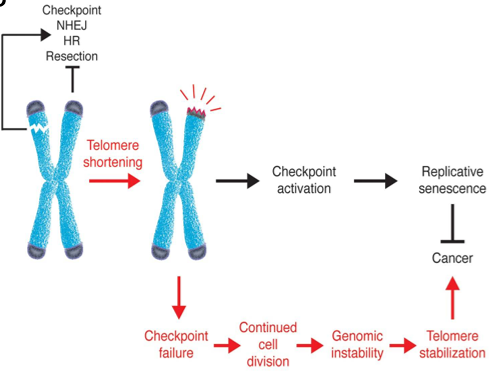14.2 Aging and Senescence
Often, when we think of the term “aging,” we envision graying hair, wrinkling of skin, and slowing of agility. We may even connect aging with the idea of slowed metabolisms and loss of muscle tone or cognitive function. However, none of these things are actually connected to chronological age. Rather, they are signs of something called senescence.
Cellular senescence is a characterized by the cessation of mitosis (cellular division that results in new body cells). Telomeres, a region of repetitive DNA at the end of each chromosome, degrades during this process, becoming shorter and of reduced quality with each instance of cellular division. It’s like making copies of copies of copies of an original document. Over time, the copies are obscured and of such poor quality, it is nearly impossible to discern the details of the original document.

With senescence, this degradation of quality slows the creation of new cells. This is what leads to graying hair, wrinkling skin, and reduced muscle tone. And these processes are not strictly connected to age. It can be caused by various forms of stress, hormonal changes, metabolic diseases, and more.

As an example, let’s look at the impact of stress on the body by exploring the impacts of one of the world’s most stressful jobs – being a United States president. Have you ever noticed how rapidly presidents seem to age? Sleepless nights, stressful decision-making, lack of time for proper diet and exercise, staving off wars and other conflict, and trying to find compromise between the wide range of legal and social issues faced by their countries – well of course it’s a stressful job! And all these things, from poor sleep to lost exercise, can result in cellular senescence.
Watch this video from Khan Academy for more detail on telomeres and cellular senescence.
the condition or process of deterioration, often but not always in alignment with age; loss of a cell's power of division and growth.
cell division required for tissue growth and repair; a type of cell division that results in two daughter cells each having the same number and kind of chromosomes as the parent nucleus, typical of ordinary tissue growth.
a compound structure at the end of a chromosome; a region of repetitive DNA sequences that protect the ends of chromosomes from becoming frayed or tangled.
a self-replicating material that is present in nearly all living organisms as the main constituent of chromosomes. It is the carrier of genetic information.
a threadlike structure of nucleic acids and protein found in the nucleus of most living cells, carrying genetic information in the form of genes.

